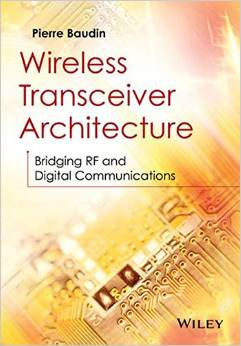 [内容简介]
[内容简介]
A fully comprehensive reference combining digital communications and RFIC (Radio Frequency Integrated Circuits) in one complete volume
There are many books which focus on the physical implementation of the RF/analog part of transceivers, such as the CMOS design, or the signal processing involved in digital communications. However, there is
little material dedicated to transceiver architecture and system design. Similarly, much of the existing literature looks at concepts useful for dimensioning, yet offers little practical information on how to proceed for dimensioning a line-up from scratch, and on the reasons for proceeding that way. This book redresses the balance by explaining the architecture of transceivers and their dimensioning from the perspective of a RFIC architect from within industry. It bridges the gap between digital communication systems and radiofrequency integrated circuit design, covering wireless transceiver architecture and system design from both system level and circuit designer aspects.
• Covers digital communication theory, electromagnetism theory and wireless networks organization, from theories to implementation, for deriving the minimum set of constraints to be fulfilled by transceivers
• Details the limitations in the physical implementation of transceivers to be considered for their dimensioning, in terms of noise, nonlinearity, and RF impairments
• Presents transceiver architecture and system design in terms of transceivers budgets, transceivers architectures, and algorithms for transceivers
[目录]
Foreword ix
Glossary xiv
I Somewhere between Maxwell and Shannon 1
Chapter 1. The digital communications point of view 3
1.1 Bandpass signal representation 4
1.2 Bandpass noise representation 36
1.3 Digital modulations examples 48
1.4 First transceivers architecture 73
Chapter 2. The Electromagnetism point of view 79
2.1 Free space radiation 79
2.2 Conducted propagation 107
2.3 The propagation channel 126
Chapter 3. The wireless standards point of view 161
3.1 Medium access strategies 161
3.2 Metrics for transmitters 169
3.3 Metrics for receivers 187
II Implementation limitations 205
Chapter 4. Noise 207
4.1 Analogue electronic noises 208
4.2 Noisy devices characterization 211
4.3 LO phase noise 259
4.4 Linear EVM 294
4.5 Quantization noise 298
4.6 Analogue vs. digital worlds conversions 322
Chapter 5. Nonlinearity 345
5.1 Smooth AM-AM conversion 346
5.2 Hard AM-AM conversion 440
5.3 AM-PM conversion, memory effect 449
5.4 Baseband devices 464
Chapter 6. RF Impairments 467
6.1 Frequency conversion 468
6.2 Gain and phase imbalance 489
6.3 Mixers implementation 508
6.4 Frequency planning 540
6.5 DC offset, LO leakage 548
III Transceivers dimensioning 553
Chapter 7. Transceivers budgets 555
7.1 Considered transceiver architecture 556
7.2 Budgeting a transmitter 557
7.3 Budgeting a receiver 599
Chapter 8. Transceivers architectures 661
8.1 Transmitters 661
8.2 Receivers 717
Chapter 9. Algorithms for transceivers 735
9.1 Transmit side 735
9.2 Receive side 774
Appendix 1. Correlations 799
Appendix 2. Stationarity 809
Appendix 3. Moments of normal random vectors 815
Bibliography 821
Index 829

 新书报道
新书报道